|
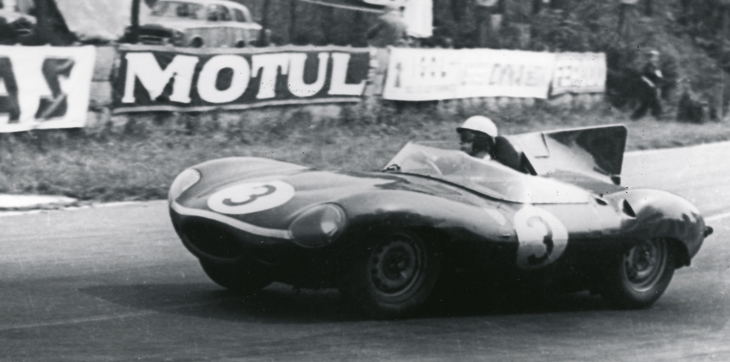
JAGUAR D-TYPE - HISTORIC LE MANS VICTORY (1957)
Jaguar's iconic D-Type sports racing car is set for an historic return to the scene of its most famous racing
victory, in a celebration of the 50th anniversary of an unparalleled 1-2-3-4-6 finish at Le Mans in 1957.
Jaguar had officially pulled out of racing in 1957, but were focused on adding to their success at Le Mans
and so provided fully-prepared D-Types for legendary Scottish team Ecurie Ecosse, which had won the previous year, to compete on their behalf. After a tough 24 hours that had taken a high toll on the finishers,
it was the partnership of Ron Flockhart and Ivor Bueb that eventually seized victory thereby making Jaguar the most successful marque in the history of the race. It was also Ron's second successive win. Right behind
were Ninian Sanderson and John Lawrence, and third place went to Jean Lucas and Jean-Marie Brussin. Belgian journalist Paul Frere and 'Freddy' Rouselle finished fourth, with Mike Hawthorn and Masten Gregory sixth.
1957 remains one of the most dominant victories in the history of the classic 24-hour endurance race, and crowned a hat-trick of wins at Le Mans for Jaguar and its innovative D-Type. These wins in turn followed on
from two earlier successes with the C-Type, winning in 1951 and 1953.
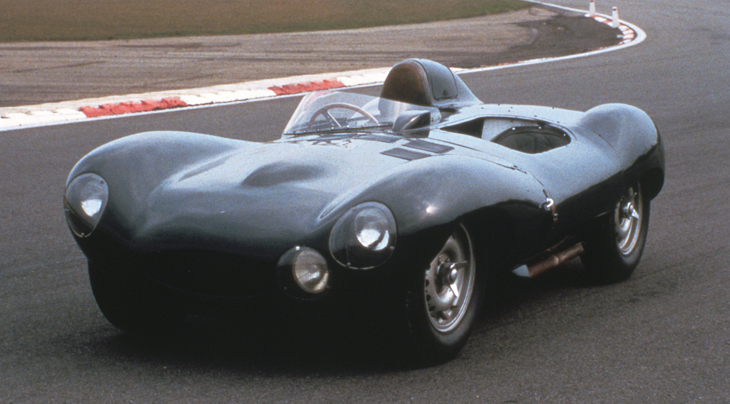
Jaguar D-Type
The Jaguar D-Type, like its predecessor the C-Type, was a factory-built race car. Although it shared the
basic straight-6 XK engine design (initially 3.4L and eventually uprated to 3.8 litres in the late fifties) with the C-Type, the majority of the car was radically different. Perhaps its most ground-breaking innovation was
the introduction of a monocoque chassis, which not only introduced aircraft-style engineering to competition car design, but also an aeronautical understanding of aerodynamic efficiency. The D-Type was introduced
purely for competition, but after Jaguar withdrew from racing, the company offered the remaining, unfinished chassis as the roadgoing Jaguar XKSS, by making changes to the racers: adding an extra seat, another door,
a full-width windshield and primitive folding top, as concessions to practicality. However, on the evening of 12 February 1957, a fire broke out at the Browns Lane plant destroying nine of the twenty five cars that had
already been completed or in semi-completion. Production is thought to have included 53 customer D-Types, 18 factory team cars, and 16 XKSS versions.
As soon as it was introduced to the racing world in 1954, the D-Type was making its presence felt. For the
1954 24 Hours of Le Mans the new car was expected to perform well, and perhaps even win. However, the cars were hampered by sand in their fuel. After the fault had been diagnosed and the sand removed, the car
driven by Duncan Hamilton and Tony Rolt quickly got back on the pace, finishing less than one lap down on the winning Ferrari.
The 1955 car incorporated the new long-nose bodywork, and the engine had been uprated with larger valves. The team again proved strong at Le Mans, and with no sand to worry about they were a good match
for the Mercedes-Benz 300 SLR cars who were hotly tipped to win. Sadly the contest was curtailed by one of the worst accidents ever to occur in motorsport: after only three hours of the twenty-four had elapsed,
Pierre Levegh's SLR clipped the tail of an Austin-Healey, sending the German machine into the hay-bale barrier. The Mercedes erupted into a flaming ball and sent burning wreckage and debris into the crowd. More
than 80 people, including Levegh, were killed, and many more injured. Mercedes withdrew from the race almost immediately, although at the time Juan Manuel Fangio was leading in his SLR, but Jaguar opted to
continue. Some blamed Mike Hawthorn for causing the crash as he swerved his D-Type in front of the Healey, setting off the tragic chain of events. Hawthorn and his co-driver Ivor Bueb went on to win the race.
Jaguar D-Type XKD606, winner of the 1957 Le Mans 24 Hours race, in Ecurie Ecosse metallic Flag Blue livery. With Mercedes deciding to withdraw from motorsport at the end of the 1955 season, the field was clear for
Jaguar to clean up at the 1956 24 Hours of Le Mans race. However, it proved to be a bad year for the works team; only one of their three cars made it to the finish, and then only in 6th place. Luckily for the D-Type's
reputation, the small Edinburgh-based team Ecurie Ecosse were also running a D-Type, driven by Ron Flockhart and Ninian Sanderson, and this car came through to win ahead of works teams from both Aston
Martin and Scuderia Ferrari. Away from Le Mans, the Cunningham Team raced several Jaguar D-Types after being offered the automobiles by Jaguar's head, Sir William Lyons, if Briggs Cunningham would stop building
his own automobiles. In May 1956, the Cunningham team's entries in the Cumberland circuit in Maryland included three of those D-Type Jaguars — characteristically painted in the pristine white-and-blue
Cunningham Team colors — for drivers John Fitch, John Gordon Benett, and Sherwood Johnston.
Ironically, after Jaguar had withdrawn from motorsport at the end of the 1956 season, 1957 proved to be the
D-Type's most successful year. In the 1957 Le Mans race D-Types took five of the top six placings; Ecurie Ecosse (with a large degree of support from Jaguar, and a 3.8L engine) again took the win, and second
place. This was the high-water mark in the car's career however.
For 1958, the Le Mans rules were changed, limiting engine size to 3 liters for sports racing cars, thus ending
the domination of Jaguar's D-Type with 3.8 liter XK engine. Jaguar developed a 3-liter version of the XK engine, which powered D-Types in the 1958, 1959 and 1960 Le Mans races. However, the 3-liter version of
the XK engine was never reliable and by 1960 was not producing enough horsepower to be competitive.
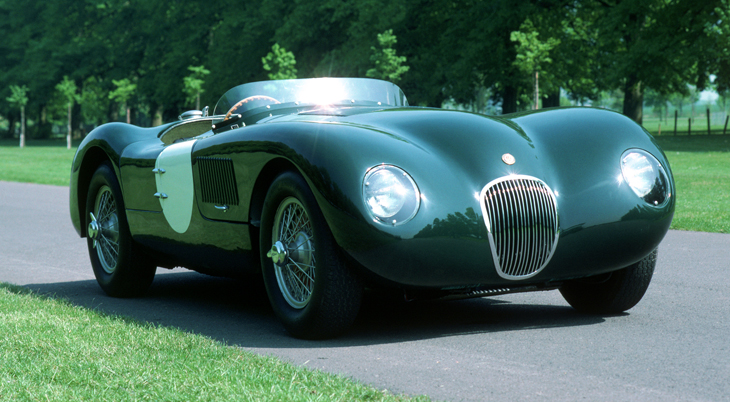
Jaguar C-Type
The Jaguar C-Type (also called the Jaguar XK120-C) is a racing sports car built by Jaguar and sold from 1951
to 1953. The "C" designation stood for 'competition'. The car used the running gear of the contemporary XK120 in a lightweight tubular frame and aerodynamic aluminium body. A total of 52 C-Types were built.
The road-going XK120's 3.4 litre twin-cam, straight-6 engine produced between 160 and 180 bhp (134 kW). The version in the C-Type was originally tuned to around 205 bhp (153 kW). Later C-Types were more
powerful, using triple twin-choke Weber carburettors and high-lift camshafts. They were also lighter, and from 1952 braking performance was improved by disc brakes on all four wheels. The lightweight,
multi-tubular, triangulated frame was designed by Bob Knight. The aerodynamic body was designed by Malcolm Sayer. Made of aluminium in the barchetta style, it was devoid of road-going items such as carpets,
weather equipment and exterior door handles.
The C-Type was successful in racing, most notably at the Le Mans 24 hours race, which it won twice.
In 1951 the car won at its first attempt. The factory entered three, whose driver pairings were Stirling Moss and Jack Fairman, Leslie Johnson and 3-times Mille Miglia winner Clemente Biondetti, and the eventual
winners, Peter Walker and Peter Whitehead. The Walker/Whitehead car was the only factory entry to finish, the other two retiring with lack of oil pressure. A privately entered XK120, owned by Robert Lawrie, co-driven
by Ivan Waller, also completed the race, finishing 11th.
In 1952 Jaguar, worried by a report about the speed of the Mercedes-Benz 300SLs that would run at Le
Mans, modified the C-Type's aerodynamics to increase the top speed. However, the consequent rearrangement of the cooling system made the car vulnerable to overheating. All three retired from the race.
The Peter Whitehead/Ian Stewart and Tony Rolt/Duncan Hamilton cars blew head gaskets, and the Stirling Moss/Peter Walker car, the only one not overheating, lost oil pressure after a mechanical breakage
In 1953 a C-Type won again. This time the body was in thinner, lighter aluminium and the original triple SU carburetors were replaced by three Webers, which helped boost power to 220 bhp (164 kW).
Duncan Hamilton and Tony Rolt won the race at 105.85 mph {170.34 km/h} – the first time Le Mans had been won at an average of over 100 mph. 1954, the C-Type's final year at Le Mans, saw a fourth place by
the Ecurie Francorchamps entry driven by Roger Laurent and Jacques Swaters.
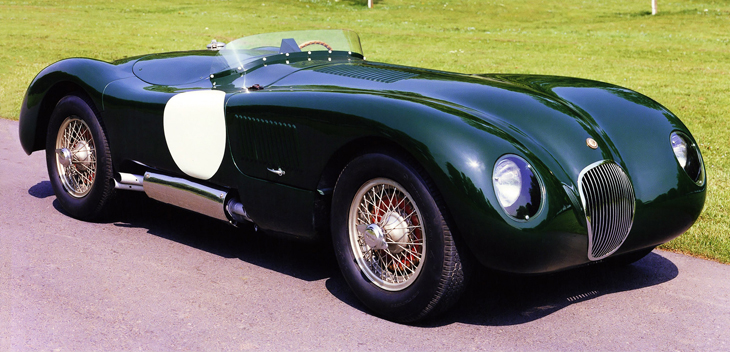
1951 Jaguar C-Type
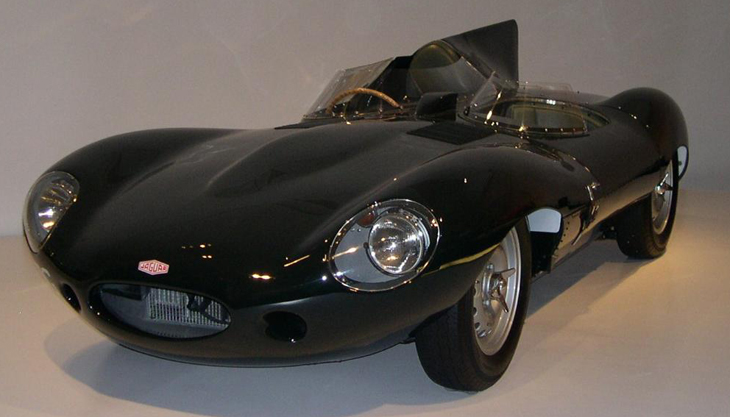
Jaguar D-Type From the Ralph Lauren collection
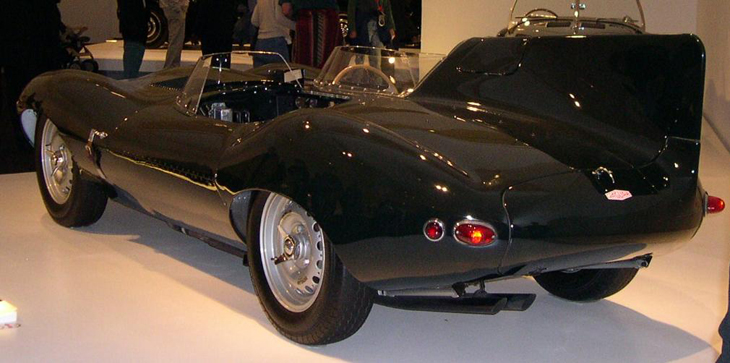
|





